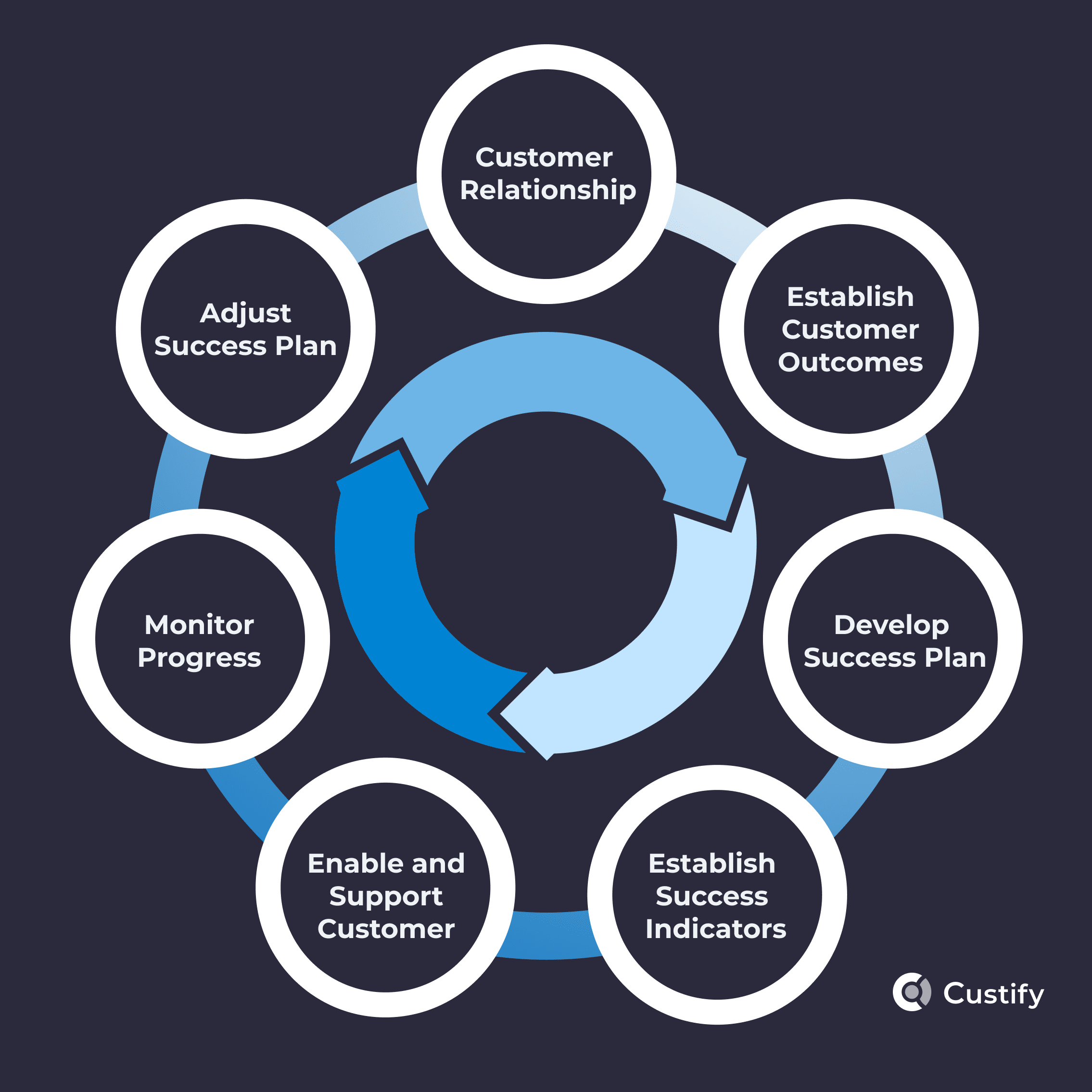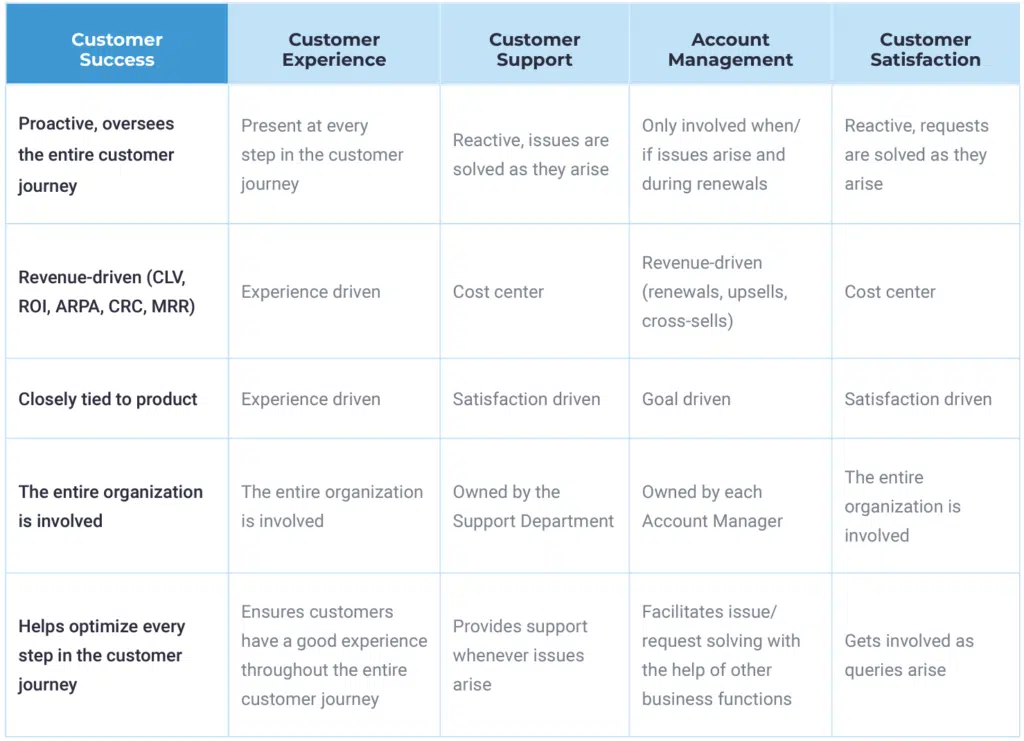What is customer success, and why is it important? In this article, I’ll dive into the essence of customer success, explore why it is crucial for businesses, and provide insights on building an effective customer success program.
I’ll also compare customer success with customer service, examine key roles and responsibilities, and highlight the essential metrics that drive success. Whether you’re new to the concept or looking to refine your strategy, this article offers valuable insights to guide your efforts.
What Is Customer Success?
Customer success is an overarching strategy for business success rooted in behavioral psychology, based on facilitating customers’ desired outcomes and overall success while programmatically anticipating issues, roadblocks, needs, and potential churn through a complex set of tactics and software. The idea is that successful customers will, in turn, enable your success, thereby allowing you both to grow together.
These practices drive revenue, loyalty, marketing, and progressively augment business growth until customer success (CS) becomes a true engine for your organization. That’s why it’s known as more than a department, more than a churn reduction tactic, and more than a support center – it’s all of them combined and more.
Customer Success is about developing and delivering on solutions for partners. It is iterative work where we are learning from what happens and considering how to improve for the next time. Success work is rooted in understanding what our customers truly need, even as those needs change, and making sure the game plan evolves with them.
This ongoing effort keeps us in tune with our customers and makes sure we’re always ready to support them, ensuring they are supported and realize value.
– Keishla Ceaser-Jones – Customer Success Leader | Top 100 CS Strategist, EAB (Candid Leader Insights Podcast, Episode 15)
What Do Businesses Achieve through Customer Success?
Through customer success, organizations today achieve unparalleled levels of growth that were only dreamed-of before CS became a thing. Think successes like:
- Improve trial conversion rate by 28%*. After adopting a customer success strategy and fully integrating it within their team, a client managed to immediately boost their trial-to-paid conversions.
- Increase customer messaging by 300%. Customer communication is one area that easily benefits from CS because it allows for automated messages to go out based on complex triggers, thereby improving the relevancy of those messages, leading to better interactions.
- Increase the number of accounts managed by 150%. With the same number of people, I might add. We’ve consistently seen that honing in on customer success and developing a consistent strategy leads to more time for working on complex issues, leaving the rest to automation.
- Increase customers by >230%. CS doesn’t just improve processes, it actively drives revenue through its work on optimizing onboarding, training materials, product tours, and by manually helping customers reach the activation stage.
- Decrease average churn by 24%. One of the chief concerns of CS since its inception at Salesforce in the early 2000s, reducing churn can now be done at a much larger scale, more effectively, predictably, and smarter even – as today’s CSMs know they shouldn’t obsess over poor-fit customers and instead focus on the actual drivers of revenue.
- Derive ROI directly from CS efforts. Through all these efforts combined, customer success can become the true revenue driver it was destined to be – by reducing churn, facilitating expansion revenue.
*Data-driven examples from our portfolio, serving merely as a sample of the kind of shifts and changes a CS-aligned organization can achieve.
Customer Success vs Customer Service vs Account Management vs Customer Experience vs Customer Satisfaction
We’ve spoken about these differences multiple times and in hindsight, the most important thing to remember is that customer success permeates and incorporates all the others. How?
- It deals with CX
- Customer support needs to work with CS in mind
- Account managers are more or less under the CS umbrella, even if they’re not CSMs
- Customer satisfaction is one metric and survey most everyone in the business uses or looks at.
Here’s a full side-by-side review of all these related concepts:
What Is Customer Success Management?
Customer Success Management is all about ensuring customers achieve their desired outcomes while using your product or service. It represents both the higher-up functions within this profession, as well as the idea of managing customer success across an organization. This involves understanding what success looks like for your customers and aligning your resources to help them achieve these goals.

First, get to know your customers’ needs and expectations. Sometimes, they may not fully realize what your product can offer, so it’s also about educating them on what’s possible.
Next, help customers develop a success plan tailored to these goals. This plan should include training, best practices, and ongoing support. While you may not necessarily be the person or department in charge of executing this plan, it is your role as a customer success manager to enable your customers to be successful.
Finally, customer success management is about building a long-term relationship. It’s not just about the initial setup but continuously evolving your products and services to provide ongoing value and support to your customers.
Is Customer Success In SaaS Different?
Customer Success started with SaaS. Or, at the very least, that’s when it had its big break – it was the summer of 2005, people were listening to Crazy Frog, Katrina was devastating the US South, and the team at Salesforce was in a death spiral, showing some wild levels of monthly customer churn (8%, the equivalent of 80% customers lost in a year).
So what happened?
They launched the largest customer success department in the world. Their goal was to increase retention. They aimed for better tactics to drive user adoption. For example, C-level customers were paying for Salesforce, but nobody was using it as people still preferred doing things the old-fashioned way (remember, it was 2005). This entire effort led to their success, eventually helping establish the three pillars of customer success in SaaS today:
- Optimize onboarding
- Ensure adoption
- Increase the value of installed accounts (aka upsells)
So, to sum up, you could say that any approach to customer success relies on the initial SaaS application. However, that’s not to say customer success can’t be powerful outside of SaaS – in fact, the philosophy behind CS is a great one to apply to any business, if done with careful consideration and due diligence.
Why Is Customer Success Important and How Does It Work?
Customer success works by strategically aligning the entire business on CS principles. Typically, that’s an effort spearheaded by the first CSM in the company, or the Head of CS if it’s a larger team from the get go. The idea is for everyone to not only understand CS, but understand it in the context of their customers:
- what they want
- why they came to you in the first place
- and how you are able to deliver that to them
- how fast you can bring them to value realization
- and lastly, what you can provide along the way – be it updates, assistance, or freebies – to keep their Time to Value low so they remain active and engaged until they eventually reach their goals.
As to why Customer Success is important, we’ve asked this exact question to some of the CSMs we’ve talked to over the years. Here’s what they had to say:
Customer Success represents the continuous pursuit of delivering maximum value from our solutions to our customers, which in turn, helps them to accomplish their own business objectives. The responsibility is multi-dimensional, dynamic, and never-ending. Too often we think of customer success as a function, but in actuality, it is a holistic motion, delivered by many contributors, that is realized as an overall experience. How your customers experience your solution and your teams will ultimately dictate whether or not they continue to be a customer. If there is not enough value, the customer will churn, and the economics have proven to us that to lose an existing customer and replace it with a new customer is an extremely costly endeavor. Therefore, the importance of Customer Success can’t be understated. If you want to grow your business, you have to make sure you are helping your customers grow theirs.
– Parker Chase Corwin, CS & CX Consultant and Advisor
For me, it’s the heart of customer centricity and a central team that brings customer at the forefront of the company and connects other divisions i.e. Sales, Product, Marketing with the customer lens. It’s also some of the most amazing (and empathetic) bunch of people I’ve worked with.
– Madhur Choudhary – CS Leader | Coach | Director of CS, Trackunit
We see Customer Success as the secret sauce that makes everything taste better. It’s not just about solving problems or answering questions; it’s about really getting to know what drives each customer. For instance, when we help a client streamline their workflow, it’s not just about the tech. It’s about freeing up their time so they can focus on growing their business. This personal investment in their goals builds a partnership that goes beyond the usual customer-service provider relationship. It’s these connections that transform our service into a genuine business accelerator for both us and our clients.
– Philipp Wolf, Founder & CEO, Custify
Read more: Why Is Customer Success Important to You? CS Leaders Answer – Custify Blog
Adding to this, you can also see the importance of customer success by looking at the expansion charter year-over-year. According to TSIA’s 2023 State of Customer Success Report, investment in customer success grew by 10% in 2015, 38% in 2017, 39% in 2019, 49% in 2021, and an impressive 62% in 2022. So the more customer success grows, the more businesses become aware of its value and choose to further invest in this approach.
Key Benefits of Customer Success
1. Prevents and Reduces Customer and Revenue Churn
According to the most recent trends, 73% of CSMs still consider customer churn as one of their main challenges. As they should – having a team specifically handle retention efforts frees up a lot of time for the rest of the company. Not only that, but CSMs doesn’t simply react to churning customers, they work to put churn prediction and prevention programs in place, including tactics such as:
- Conducting churn analyses for the entire customer base
- Creating predictive models based on CSP data
- Implementing proactive reachout scripts and workflows
- Automating customer communications with data-led triggers
- Acting directly based on user feedback for leading accounts
- Reaching back out to report to users whose feedback was useful
With all these strategies put together, CS has been proven to reduce churn, with 79.3% of CSMs saying that simply identifying at risk accounts has led to lower churn rates, while 64.1% said regular customer communication also proved successful as an anti-churn measure.
2. Optimizes Customer Onboarding and Grows Adoption Rate
Customer onboarding is a critical moment in the user journey. Some venture as far as to call it the most important one and I tend to agree.
Onboarding defines the tone of the relationship between a customer and your company. It is the moment when they learn the specifics about your product or services, what you can offer, what they can do on their own, and everything in between.
For many customers, onboarding acts like a test – did they make the right decision? are you the one to solve their biggest issues? how can they make the most out of this business choice?
Depending on the cost of your product / services, you could be under more scrutiny than you might realize or expect. One way we’ve navigated around this at Custify is by providing what we call concierge onboarding for all our customers, since the beginning:

3. Upsells Customers and Increases Expansion Revenue
Upsells and cross-sells are a tenet of customer success. As said previously, expansion revenue has always been a part of the discussion.
So how does this fit in with the idea of enabling customer outcomes?
Simple – everyone in business knows you have situations where clients might accomplish their goals faster and smarter if they had the X or Y feature in the product. That’s the basis of upsells – you’re aiming to help customers get to that point while also driving revenue for your business. Most of the time, it’s a win-win, if done authentically.
4. Helps Customers Realize the Value of Your Partnership
Sure, we’ve seen CS is valuable, but how much does it add to actual business growth? Quite a lot, it seems, as 30% of CS teams report directly to the CEO, underscoring their value within their respective organizations.
In fact, we’ve seen in our review of top positions like Directors and VPs of Customer Success that one of the main responsibilities that comes with seniority is “business development.”
What does that mean?
It means lead CSMs take your best fit accounts and turn them into high-value business partnerships. This in turn can lead to collaborative efforts and newfound opportunities for growth. And the best part is the tactic fits neatly in the value realization process I talked about earlier.
5. Safeguards the Renewal Rate and Promotes Scalability
Lastly on our list, we’ve got to talk about scalability. Whatever workaround you may have for handling churn, without a concerted customer success drive, it’s never going to get off the runway or be scalable.
Customers change and businesses along with them. So using a process that worked for at-risk accounts 2 years ago will almost always result in failure. In fact, we’ve seen recently that in SaaS, 60% of the data collected within a day becomes obsolete by the end of that day. Pretty scary right?
That’s where customer success comes in. CSMs maintain an overview of all your accounts with clear and hygienic datapoints that they check constantly for imperfections, churn precursors, upsell chances, and business growth opportunities. From a C-level perspective, it’s like having your very own NASA control room in charge of accounts. Isn’t that the dream?
Want to learn more? To see how CSMs work in their day-to-day towards implementing these tactics, check out our Customer Success Strategy Guide.
Regular check-ins, tailored solutions, and continuous communication ensure a seamless and positive client experience, which is the definition of customer success.
– Eugenia Covali, Regional Customer Success Director at Bloom Coding
What’s the Best Customer Success Solution for Your SaaS?
Customer success teams will often struggle to find the right tool for their daily workflows. Many times, they’re stuck with the CRM because it’s the one they already have, or the customer support tool because it covers some of the same areas. In fact, looking at the graph below, we can see many CSMs typically share the tools used by other teams:

Source: TSIA Customer Success Benchmark Data
While 57% use dedicated CS tools, many clearly rely on CRMs, Support Tools, or some form of Homegrown tool (i.e. they use a mess of spreadsheets and emails, from my experience).
Furthermore, what the pie-chart from TSIA tells us is that 93% of CSMs use more than one tool (adding up all the percentages leads us to 193%). That makes sense – when you’re in CS, you always have to check other tools, even if you do have your own dashboards.
But I’d like to argue that most customer success teams need a dedicated customer success platform to be effective. And that’s not just because Custify’s one of the most powerful and useful CS tools out there, it’s also because I’ve seen CSMs tormented by the lack of proper solutions for their job, and the truth is there’s only so much we can do in Excel before we reach diminishing returns.
FAQs about Customer Success
What are customer success operations?
Customer success operations, also called simply CS Ops or Customer Operations, is a subset of customer success that has to deal with everything from KPIs to metrics, workflows, tools, tactics, implementation, and more.
CS Ops is often in charge of data-driven efforts, oversees data hygiene, and makes sure everything runs smoothly from a technology point of view.
What is a customer success specialist?
Customer success specialists are entry-level CS roles that handle many of the day-to-day monitoring and communication tasks. Depending on the organization, the scope of CS specialists may vary, but is generally limited and overseen by either the Head of CS or another CSM.
What is a customer success executive?
A customer success executive can be any role involved in executing CS tactics, however the term is often used to describe C-level CS functions, such as a Chief Customer Officer or a VP of Customer Success.
What is a customer success associate?
A customer success associate is another term of a customer success specialist. I’ve also seen it used instead of CSM. Oftentimes, an associate is a freelancing contractor, but not always. However, it is generally understood that a CS associate is an entry-to-mid level role in an organization.
What is customer success in tech?
Customer success often exists as an approach and a team within tech companies, though it’s not required. The two models are extremely compatible, particularly seeing as Salesforce, a famous Silicon Valley company, is the leading example of a Customer Success effort done right. However, customer success teams can exist in non-tech sectors. To put it simply, all tech companies can use customer success, but not all customer success departments work in tech.
What is customer success enablement?
Customer success enablement is a process, and sometimes a person (i.e. the CS enablement manager), that helps the CS team secure all the solutions, tech, resources, training, and funding they need to actually achieve their objectives. CS enablement often occurs within medium-to-large organizations and enterprises.
What is customer success software?
Also called a customer success platform, CS software is the tool a customer success team uses to monitor customer activity, determine points of friction, automate messaging, calculate health scoring per account, identify expansion opportunities, create tasks and alerts, and, of course, compile their reports. It’s also sometimes called a customer success management platform.
Customer Success Software, also known as a Customer Success Platform (CSP), is a vital tool for businesses to monitor, manage, and enhance their customer relationships. These platforms offer features such as product usage analytics, customer health scores, onboarding tools, customer feedback surveys, and support management. By leveraging these tools, businesses can gain actionable insights to preemptively address customer needs, boost satisfaction, and reduce churn.
Key Benefits of Customer Success Software:
Understanding Customer Behavior:
- Gain in-depth insights into customer interactions with your product.
- Personalize the customer experience to foster loyalty and retention.
Revenue Growth:
- Identify upselling and cross-selling opportunities through visibility into product usage.
- Drive expansion revenue by tailoring offerings to customer needs.
Operational Efficiency:
- Automate routine customer management tasks to save time and resources.
- Enable Customer Success Managers (CSMs) to focus on strategic initiatives.
Custify as a Practical Example:
Custify is a leading example of a Customer Success Platform, offering a comprehensive suite of features designed to optimize customer success. Here’s how Custify stands out:
Automated Playbooks:
Create and customize workflows for various customer scenarios, ensuring timely and relevant engagement.
Dynamic Assignment:
Efficiently distribute workloads with round-robin assignments and user tags, ensuring balanced and effective customer management.
Smart Signals:
Utilize AI-powered notifications to stay proactive, addressing potential churn signs with real-time alerts.
Integration with CRM Tools:
Seamlessly connect with CRM systems like HubSpot and Salesforce to ensure all customer data is up-to-date and accessible, enabling a holistic view of customer interactions.

With Custify, SaaS businesses transform their customer-facing efforts, ensuring that each CSM can focus on their goals, not mundane tasks or reports. Our clients regularly see massive drops in churn and improved customer onboarding.
What is the customer success department?
Simply put, the customer success department is the team that oversees customer success efforts, alignment, and collaboration within a company. The department can be as small as a single CSM or as large as multiple teams with their own Lead CSMs. It all depends on the size of the organization, customer base, and the engagement model required to service those customers (low touch / high touch / tech touch).
What Does Customer Success Mean to You?
Now that I’ve walked you through the winding path to the book of customer success, what’s your take on it? Is it a new team you’re excited to add to your organization or are you just hearing about the concept and want to learn more?
Either way, Custify stands ready to be your helping hand, be it through our fully-featured CS software or through our series of guides, articles, webinars, and podcasts that you can find on our blog. Whatever your journey through CS, we plan on laying the groundwork so you can run!





